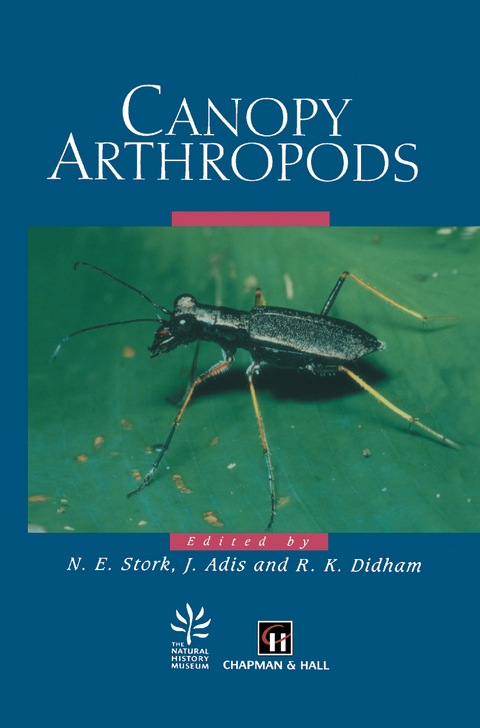
Canopy Arthropods
Chapman and Hall (Verlag)
978-0-412-74900-1 (ISBN)
During the last twenty years recognition of the importance of canopy arthropods to global biodiversity and the crucial roles arthropods play in forests has led to a revolution in the study and understanding of the arthropod community structure in the forest canopy. Recent advances have been greatly aided by the development of improved sampling techniques and new methods of access to the forest canopy.
Canopy Arthropods brings together for the first time a wide range of the most recent studies of arthropods living in forest canopies and comes from a truly international team of contributors.
List of contributors. Preface. Part One: Methods of Studying Arthropods in Trees. 1. Sampling arthropods from tree-crowns by fogging with knockdown insecticides: lessons from studies of oak tree beetle assemblages in Richmond Park (UK); N.E. Stork, P.M. Hammond. 2. A review of methods for sampling arthropods in tree canopies; Y. Basset, N.D. Springate, H.P. Aberlenc , G. Delvare. 3. Advances in using the canopy fogging technique to collect living arthropods from tree-crowns; W.Paarmann, K. Kerck 4. Knockdown efficiency of natural pyrethrum and survival rate of living arthropods obtained by canopy fogging in Central Amazonia; J. Adis, W. Paarmann, C.R.V. da Fonseca, J.A. Rafael. Part Two: Community Structure of Coleoptera Assemblages. 5. Beetle species diversity and faunal similarity in Venezuelan rainforest tree canopies; J.G. Davies, N.E. Stork, M.J.D. Brendell, S.J. Hine. 6. Host-specificity and the effective specialization of tropical canopy beetles; N.A. Mawdsley, N.E. Stork. 7. Determinants of species richness in assemblages of canopy arthropods in rainforests; R.L. Kitching, et al. 8. Canopy arthropods of coastal Sitka spruce trees on Vancouver Island, British Columbia, Canada; N.N. Winchester. 9. The beetle fauna of different tree species in forests of Rwanda and East Zaire; T. Wagner. 10. Tree-crown beetles in context: a comparison of canopy and other ecotone assemblages in a lowland tropical forest in Sulawesi; P.M. Hammond, N.E. Stork, M.J.D. Brendell. 11. Patterns of beetle species diversity in Castanopsis acuminatissima (Fagaceae) trees studied with canopy fogging in mid-montane New Guinea rainforest; A. Allison, G.A. Samuelson, S.E. Miller. 12. Species abundance and body size relationships in insect herbivores associated with New Guinea forest trees, with particular reference to insect host-specificity; Y. Basset. 13. Arthropod biodiversity in the canopy of New Caledonian forests; E. Guilbert. Part Three: Community Structure of Non-Coleopteran Assemblages. 14. Diversity of an Amazonian canopy grasshopper community in relation to resource partitioning and phylogeny; C. Amedegnato. 15. Dipteran tree-crown assemblages in a diverse southern temperate rainforest; R.K. Didham. 16.Diversity and recolonization dynamics of selected arthropod groups on different tree species in a lowland rainforest in Sabah, Malaysia with special reference to Formicidae; A. Floren, K.E. Linsenmair. 17. The ant fauna of tree canopies in Central Amazonia: a first assessment; A.Y. Harada, J. Adis. 18. Estimation of arboreal and terrestrial arthropod densities in the forest canopy as measured by insecticide smoking; H. Watanabe. Part Four: The Biology of Canopy Arthropods. 19. The ecology and behaviour of arboreal dung beetles in Borneo; A.J. Davis, J. Huijbregts, A.H. Kirk-Spriggs, J. Krikken, S.L. Sutton. 20. Studies on the biology of a canopy-dwelling carabid beetle collected by canopy fogging in the rainforest of Sulawesi (Indonesia); W. Paarmann, D. Paarmann. 21. Bioacoustic monitoring of insect communities in a Bornean rainforest canopy; K. Riede. 22. Spatial and temporal use of microhabitats as a key strategy for the colonization of tree bark by Entomobrya nivalis L. (Collembola: Entomobryidae); A. Prinzing. 23. The epiphytic lichen Evernia prunastri L. as a habitat for arthropods: shelter from desiccation, food-limitation and indirect mutualism; A. Prinzing, H.-P. Wirtz. Part Five: The Management and Conservation of Canopy Arthropods. 24. Distinguishing the woods from the trees; B.J. Richardson, S. Burgin, F.F. Azarbayjani, S. Lutubula. 25. Insect biomass in Amazonian forest fragments; J.R. Malcolm. 26. The significance of edge effects in the management of forests for invertebrate biodiversity; C.M.P. Ozanne, C. Hambler, A. Foggo, M.R. Speight. 27. Canopy arthropod studies for the future; N.E. Stork, R.K. Didham, J. Adis.
| Erscheint lt. Verlag | 31.12.1996 |
|---|---|
| Zusatzinfo | XVI, 568 p. |
| Verlagsort | London |
| Sprache | englisch |
| Maße | 156 x 234 mm |
| Themenwelt | Naturwissenschaften ► Biologie ► Evolution |
| Naturwissenschaften ► Biologie ► Ökologie / Naturschutz | |
| Naturwissenschaften ► Biologie ► Zoologie | |
| ISBN-10 | 0-412-74900-9 / 0412749009 |
| ISBN-13 | 978-0-412-74900-1 / 9780412749001 |
| Zustand | Neuware |
| Haben Sie eine Frage zum Produkt? |
aus dem Bereich


